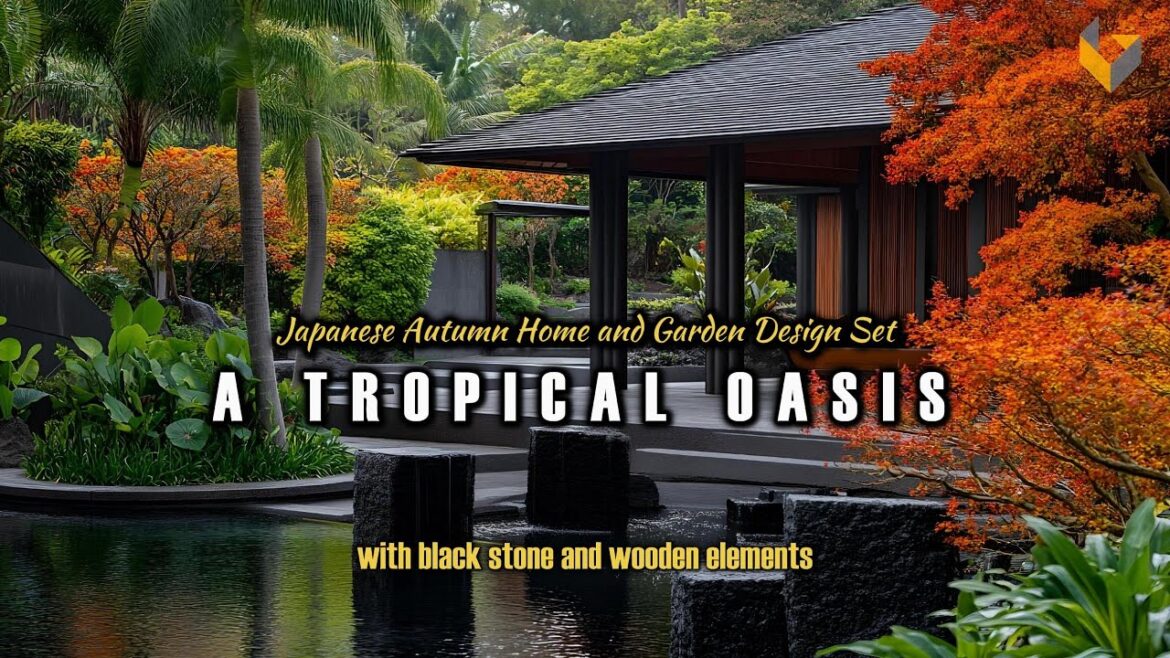The harmonious fusion of traditional Japanese aesthetics with tropical elements brings a distinctive and tranquil ambiance, particularly during the autumn season. The rich hues of fall—deep reds, burnt oranges, and golden yellows—blend seamlessly with the lush greenery of a tropical setting, creating an environment that feels both serene and vibrant. Against this colorful backdrop, the interplay of black stone and warm wooden elements introduces a striking balance of texture and tone, emphasizing the timeless elegance of Japanese design while embracing the organic warmth of the tropics.
At the heart of Japanese design lies a philosophy of simplicity, minimalism, and an intrinsic connection to nature. This is beautifully embodied in the concept of wabi-sabi, which finds beauty in imperfection and the transient nature of life. Autumn, as a season of transformation, perfectly complements this philosophy, offering an opportunity to showcase the fleeting beauty of falling leaves, crisp air, and golden sunlight filtering through the canopy. The use of natural materials such as wood and stone enhances this connection to the environment. Black stone, with its sleek modernity, contrasts exquisitely with the warm tones of wood, creating a design that is both visually stimulating and deeply calming.
In crafting a Japanese-inspired home set within a tropical oasis, the design must prioritize openness, fluidity, and a seamless integration with the natural world. Architectural elements like open floor plans, gabled roofs with overhanging eaves, and floor-to-ceiling windows emphasize a connection to the outdoors, allowing natural light and air to flow freely. Sliding doors and tatami flooring, crafted from rice straw, further underscore the authenticity of Japanese design while harmonizing with tropical materials like teak or mahogany. These choices celebrate the warmth and versatility of wood while maintaining the clean, uncluttered lines that are hallmarks of this aesthetic.
The interior color palette can draw heavily from autumnal hues, with terracotta, mustard yellow, and deep red accents bringing a cozy vibrancy to the space. These colors can be incorporated into cushions, artwork, and other decor, creating a dynamic yet harmonious visual experience. Black stone can be introduced through countertops, accent walls, or flooring to add a modern touch that contrasts beautifully with the wooden elements. Together, these materials and colors create an environment that feels grounded yet uplifting, a perfect reflection of the season.
Equally important is the garden, which serves as an extension of the home and a canvas for Japanese design principles. The garden should be a place of serenity and reflection, featuring curved pathways of gravel or stone that invite exploration. A koi pond or small waterfall can add the soothing sound of flowing water, while the vibrant foliage of Japanese maple trees showcases the dramatic colors of autumn. Tropical plants, carefully chosen to complement the Japanese aesthetic, can provide year-round greenery and texture.
To further enhance the garden’s atmosphere, elements such as traditional stone lanterns, sculptural features made from natural materials, and gravel ground cover can be incorporated. These touches reflect the understated elegance of Japanese gardens, where every detail serves to highlight the beauty of nature. Outdoor seating areas, whether wooden benches or stone perches, can provide quiet spaces for contemplation, while a modest fire pit adds warmth and invites gatherings on cooler evenings.
Lighting is an essential element, transforming the space as day turns to night. Traditional Japanese lanterns, placed strategically along pathways and near water features, create a soft, inviting glow. Up-lighting can be used to highlight key features such as trees, water elements, or sculptures, adding depth and drama to the garden’s design. These lighting choices enhance the magical quality of the space, encouraging exploration and reflection after sunset.
Celebrating autumn within this design framework means embracing the seasonal changes and incorporating them into daily life. Seasonal decor, such as decorative gourds, dried flowers, or harvest-inspired displays, can bring a festive touch to the home. Hosting gatherings, whether for tea ceremonies or outdoor dinners, allows for a communal appreciation of the garden’s beauty and the season’s bounty. Strolling through the garden, taking in the vibrant colors and crisp air, offers a moment of mindfulness and connection to nature.

